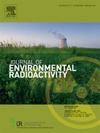Assessment of radiation contamination of villages in northeastern Kazakhstan not covered by exposure rate measurements after atmospheric nuclear weapons tests conducted at the Semipalatinsk nuclear test site
IF 2.1
3区 环境科学与生态学
Q3 ENVIRONMENTAL SCIENCES
引用次数: 0
Abstract
This paper presents the results of the first comprehensive assessment of radiation contamination of villages in Kazakhstan not covered by exposure rate measurements after atmospheric nuclear weapons tests conducted at the Semipalatinsk nuclear test site in 1949–1962. This was necessary to estimate radiation thyroid doses in 3183 individuals included in a cohort study of the prevalence of thyroid nodules detected by ultrasound, who lived during the testing period in 111 settlements where radiation measurements were not done. The values of exposure rate in these settlements were assessed using developed approaches to reconstruct the exposure rate along and across the fallout trace based on exposure rate measurements made at neighboring settlements after the same test. A total of 66 locations with measured exposure rates were available for the study. The validity of the approaches was tested using 24 pairs of exposure rates measured in villages located along the fallout trace at similar distances from the trace axis as well as by comparing with literature data. The results of this study are used to reconstruct thyroid doses in individuals who were exposed as children and young adults to fallout from atmospheric nuclear weapons tests conducted at the Semipalatinsk nuclear test site between 1949 and 1962.
对在塞米巴拉金斯克核试验场进行大气层核武器试验后未列入暴露率测量范围的哈萨克斯坦东北部村庄的辐射污染进行评估
本文介绍了1949-1962年在塞米巴拉金斯克核试验场进行大气层核武器试验后,对哈萨克斯坦未包括在暴露率测量范围内的村庄进行的辐射污染的第一次全面评估的结果。这对于估计3183人的甲状腺辐射剂量是必要的,这些人在测试期间居住在111个没有进行辐射测量的定居点,这些人被纳入了一项超声检测甲状腺结节患病率的队列研究。对这些居民点的暴露率值进行了评估,根据同一试验后在邻近居民点测量的暴露率,采用先进的方法重建沿沉降物轨迹和整个轨迹的暴露率。共有66个测量暴露率的地点可供研究。通过在距离放射性尘落物轨迹轴线相似距离的沿放射性尘落物轨迹的村庄测量24对暴露率,并与文献数据进行比较,对这些方法的有效性进行了检验。本研究的结果用于重建1949年至1962年期间在塞米巴拉金斯克核试验场进行的大气核武器试验中作为儿童和青年受到放射性尘降物影响的个体的甲状腺剂量。
本文章由计算机程序翻译,如有差异,请以英文原文为准。
求助全文
约1分钟内获得全文
求助全文
来源期刊

Journal of environmental radioactivity
环境科学-环境科学
CiteScore
4.70
自引率
13.00%
发文量
209
审稿时长
73 days
期刊介绍:
The Journal of Environmental Radioactivity provides a coherent international forum for publication of original research or review papers on any aspect of the occurrence of radioactivity in natural systems.
Relevant subject areas range from applications of environmental radionuclides as mechanistic or timescale tracers of natural processes to assessments of the radioecological or radiological effects of ambient radioactivity. Papers deal with naturally occurring nuclides or with those created and released by man through nuclear weapons manufacture and testing, energy production, fuel-cycle technology, etc. Reports on radioactivity in the oceans, sediments, rivers, lakes, groundwaters, soils, atmosphere and all divisions of the biosphere are welcomed, but these should not simply be of a monitoring nature unless the data are particularly innovative.
 求助内容:
求助内容: 应助结果提醒方式:
应助结果提醒方式:


